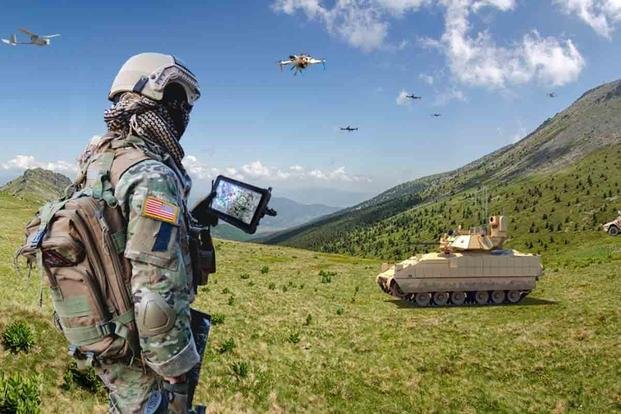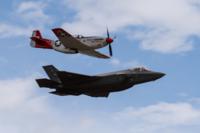President Barack Obama once remarked that the U.S. military has fewer horses and bayonets than it did in 1916 because the nature of warfare has changed over the years. The needs and capabilities of the U.S. military has changed along with it.
There’s no doubt that the 20th century was a transformative era for the United States and the way it fights its war. Just two decades into the 21st century, it’s becoming apparent that this 100 years will be as revolutionary as the last 100.
On a recent episode of Military.com’s podcast Left of Boom, host and managing editor Hope Hodge Seck talked to futurists Peter W. Singer and August Cole about the technological advancements sparking the military’s 21st-century changes.
They discussed their works of military fiction that have been so eerily prescient in the realm of technology, they forced the Defense Department to take notice.
Here are five of those technologies that are coming true.
1. Cyber Warfare
In their 2015 book “Ghost Fleet,” Singer and Cole create a world where China and Russia have teamed against the United States to negate every technological advantage the U.S. currently enjoys. GPS has been taken out, China can track American ships and submarines using Cherenkov radiation and compromised microchips have taken down the most sophisticated U.S. aircraft.
The United States falls back to its low-tech “Ghost Fleet” of naval reserve ships, as well as aircraft from “the Boneyard” at Davis-Monthan Air Force Base in Arizona to move troops into Chinese-occupied Hawaii. Meanwhile, private companies join in with their existing abilities. Walmart uses its supply chain to supply rebels, and Silicon Valley tech firms go to cyber war in space.
The book’s detail forced the U.S. military's senior leadership to explore if the scenario played out in it really could happen.
2. Artificial Intelligence
In May of 2020, the duo published “Burn-In: A Novel of the Real Robotic Revolution,” which has been described as “scary” and an “authoritative look into the future.” It’s nonfiction research on AI and automation folded into a fictional storyline about the hunt for a cyber terrorist.
To catch him, law enforcement uses augmented reality glasses and self-driving vehicles fed by algorithmic updates computed by machine learning. While this all sounds great, the authors note the unexpected consequences of automation; droves of unemployed workers on the streets, addicted to virtual reality fantasies. A human FBI agent teams with a new kind of robot as a partner, to tackle a radicalized technological refugee intent on real-world destruction. The technology in the book sounds like science fiction, but it is based on actual tech currently being developed.
3. “Loyal Wingman”
Boeing is developing a hybrid drone-jet designed to be a “sidekick” to fourth- and fifth-generation fighter aircraft. The autonomous drones are designed to use AI to fly in support of manned fighters to gather information about a target area or enemy capabilities before a strike occurs.
This is another technology that is already in the testing phase, as three defense contractors have put forward designs for a Loyal Wingman drone -- but the Royal Australian Air Force already has begun testing Boeing’s prototype.
4. Future Tech Simulation
Military leaders and planners want to know if the United States can tackle an adversary that can match its technological capabilities -- and if so, what the best way of going about the task would be. In a 2019 exercise, the U.S. Army used the Maneuver Battle Lab's Modeling and Simulations branch to do just that.
The exercise integrated current U.S. weapons systems and assets along with future vehicles currently in development but untried in a real-world scenario. These innovations include the robotic combat vehicle and Future Vertical Lift helicopters. One of the most important takeaways from the exercise was an understanding of what’s happening on the battlefield and being able to stay ahead of the enemy.
5. 3D Printing
According to Singer and Cole, 3D printing potentially can alter the way the U.S. military -- and anyone else -- thinks about logistical planning.
“... being able to create their own spare parts takes us back to the definition of an arsenal,” says Singer. “An arsenal used to be where militaries made their own weapons. … No private sector is going to make our weapons, and the arsenal's just where we store it. So it offers that huge amount of change. However, it also offers it to adversaries.”
3D printing makes an appearance in their book “Burn-In.” It allows for anyone to produce a whole range of materials, from untraceable weapons, tools or almost anything else. The United States Marine Corps recently 3D-printed an entire bridge at Camp Pendleton, meaning future logistical challenges may not be so challenging.
For the entire episode, tune in to this and other episodes of Military.com's "Left of Boom" podcast on iTunes, Google Podcasts, Spotify, TuneIn and Stitcher.
Follow host Hope Hodge Seck on Twitter @HopeSeck.
-- Blake Stilwell can be reached at blake.stilwell@military.com. He can also be found on Twitter @blakestilwell or on Facebook.
Want to Learn More About Military Life?
Whether you're thinking of joining the military, looking for post-military careers or keeping up with military life and benefits, Military.com has you covered. Subscribe to Military.com to have military news, updates and resources delivered directly to your inbox.










